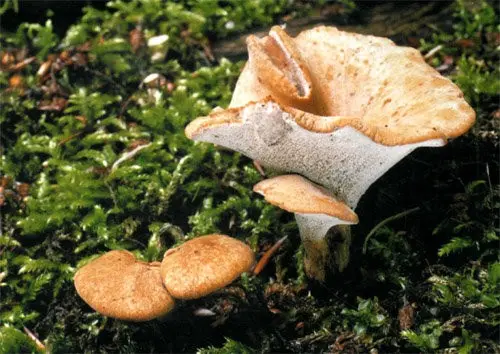Polypore is changeable (Cerioporus varius)
- Division: Basidiomycota (Basidiomycetes)
- Subdivision: Agaricomycotina (Agaricomycetes)
- Class: Agaricomycetes (Agaricomycetes)
- Subclass: Incertae sedis (of uncertain position)
- Order: Polyporales (Polypore)
- Family: Polyporaceae (Polyporaceae)
- Genus: Cerioporus (Cerioporus)
- Type: Cerioporus varius (variable polypore)

Hat: Small fruiting bodies of this fungus develop on fallen thin branches. The diameter of his hat is up to five centimeters. In youth, the edges of the cap are tucked up. Then the cap opens, leaving a deep depression in the central part. The cap is densely fleshy, thin at the edges. The surface of the cap is smooth, ocher or yellowish-brown in color. In mature mushrooms, the hat is fibrous, faded. Tubes of light ocher color run down from the cap to the leg. In rainy weather, the surface of the cap is smooth, shiny, sometimes radial stripes are visible.
Flesh: leathery, thin, elastic. It has a pleasant mushroom aroma.
Tubular layer: very small white tubules, slightly descending along the stem.
Spore powder: white. Spores are smooth cylindrical, transparent.
Leg: thin and rather long leg. Up to seven cm high. Up to 0,8 cm thick. The velvety leg is straight, slightly expanded at the top. The surface of the leg is black or dark brown. As a rule, the leg is placed in the center. At the base there is a clearly defined black, velvety zone. Dense. Fibrous.
Distribution: Changeable tinder fungus occurs in forests of various types. Fruits from mid-summer to mid-autumn. It grows on the remains of deciduous trees, on stumps and branches, mainly beech. It occurs in places, that is, you can never see it.
Similarity: for a not very experienced mushroom picker, all Trutoviki are about the same. Despite its variability, Polyporus varius has many distinguishing features that distinguish it from other fungi of this genus. Such a difference is its developed black leg, as well as small pores and a white tubular layer. Sometimes Variable Tinder fungus can be mistaken for the inedible Chestnut Tinder fungus, but the latter has larger fruiting bodies, a glossy surface, and a completely black stem.
Edibility: despite the pleasant mushroom smell, this mushroom is not eaten.









